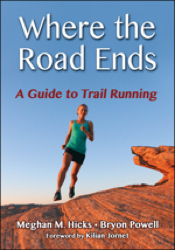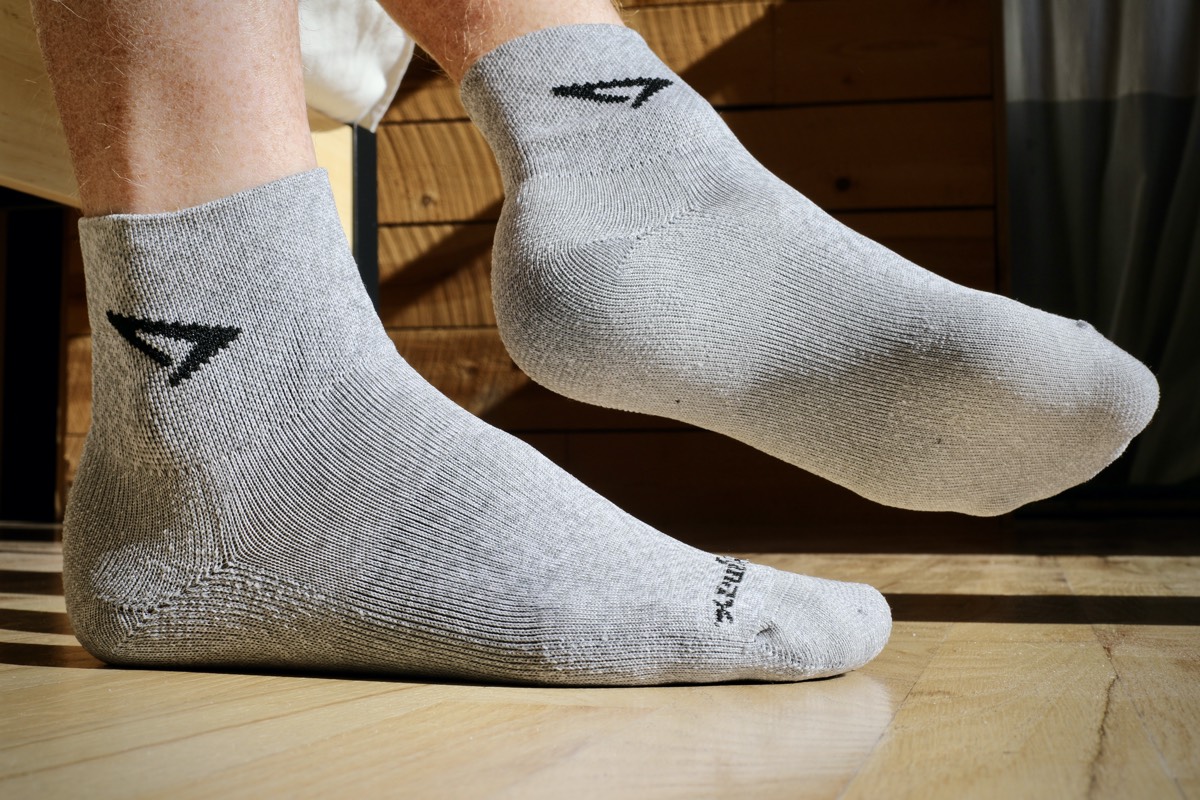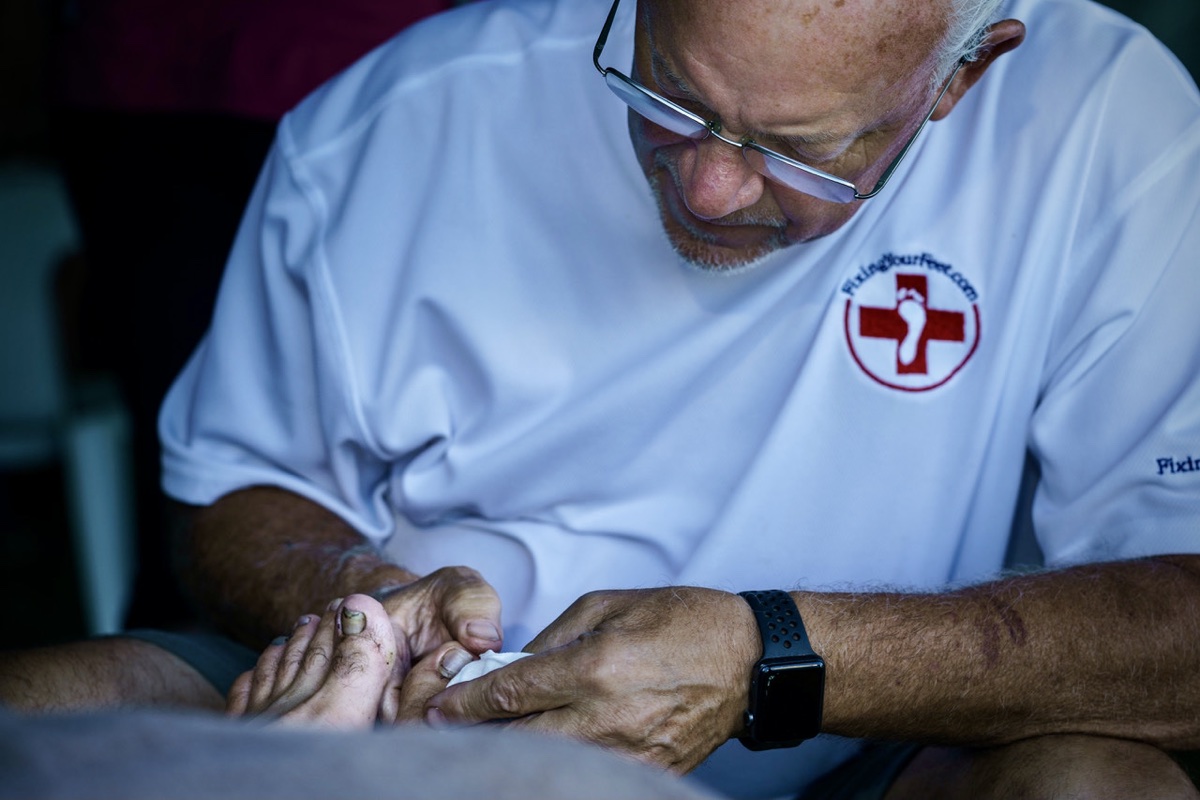
If you enjoy this article, then get your own copy of the book “Where the Road Ends!”
Welcome to this month’s edition of “Where the Road Ends: A Guide to Trail Running,” where we help you take care of your feet for running.
“Where the Road Ends” is the name of both this column and the book Meghan Hicks and Bryon Powell of iRunFar published in 2016. The book Where the Road Ends: A Guide to Trail Running is a how-to guide for trail running. We worked with publisher Human Kinetics to develop a book so anyone can get started, stay safe, and feel inspired on the trail.
The book teaches you how to negotiate technical trails, read a map, build your own training plan, understand the basics of what to drink and eat when you run, and so much more. This column aims to do the same by publishing sections from the book, as well as encouraging conversation in the comments section of each article.
In this article, we bring you an excerpt from Chapter 11 to share ideas about foot care. Throughout this article series and the book it’s based on, we share the benefits of planning. A little knowledge, a good plan of action, and the right preparation yield positive trail running experiences. On every run, your feet hit the ground thousands of times. They take a literal beating in this sport. Read on to learn how to ready your feet as much as possible to reduce the chances of foot problems.
Shoe Size, Fit, and Lacing Techniques
Happy feet begin with a comfortable pair of running shoes. Hundreds of suitable running-shoe models are out there, and surely some of them fit your feet better than others. Seek them out!
Shoe sizing and fit are a matter of personal preference, but these tips should get your feet headed in the right direction toward maximal comfort. Some shoe experts recommend wearing a trail shoe that’s a half size larger than your regular running shoe to accommodate your toes in the front of the shoe on steep downhills, but that additional room can sometimes create too much extra space elsewhere in the shoe.
A properly fitted shoe for trail running will provide about a half inch (about 1 centimeter) of space between the end of your longest toe and the front of the shoe’s toebox. When you are running downhill, your feet may move forward a bit, and this extra space helps prevent your toes from banging against the front of the toebox.
Your trail running shoes should otherwise offer the sort of toebox fit that you prefer. Some people find that they prefer a more glove-like fit in the toebox, whereas others want a looser fit so that their toes can wiggle and splay to help provide balance.
The rest of the fit of your shoe, through the midfoot to the heel, should be relatively snug. You will find that when the midfoot of the shoe envelops your own midfoot well, you will feel stable and as if the shoes are part of your feet rather than something foreign attached to them. You’ll achieve that midfoot snugness through a combination of shoe fit and lacing, a topic to be addressed shortly.
Your heel should sit snugly into the heel cup of your trail running shoe. Although you don’t want to have too much movement of your heel in the shoe, you also don’t want to have to wedge your heel in. If the fit of the heel is too tight or too loose, you are likely to suffer serious blistering problems on the backs of your heels.
You can attain a more custom shoe fit through varied lacing. For example, some trail shoes offer an extra top eyelet that, when you thread your laces through it, helps some people achieve a snugger shoe fit that feels more secure while trail running. Runners with low-volume or long, thin feet can especially benefit from this feature, as can those with small ankles. You can also alter the tightness of your laces in certain places across the top of your feet to achieve a slightly different fit. For instance, some people like to loosen the laces above the toes and tighten the laces over the midfoot.
Others prefer the laces over the midfoot to be a little bit looser than the laces up toward the ankle, especially when they’ll be descending a great deal. When you look at the tops of your feet, you’ll notice an intricate array of muscles and tendons. You also have several nerves passing through the tops of your feet. Altering your lacing techniques ever so slightly can make the tops of your feet — with all those tendons, muscles, and nerves — more comfortable.
Although uncommon, the ankle collar, the upper ring of the shoe that contacts your lower leg, may bang uncomfortably into the bottom of your outer anklebone. If this happens more than once in a pair of shoes, you should find another shoe with a lower ankle collar.
Sock Choice
These days, choosing trail running socks is like going to a buffet. Just as you need to find a shoe that feels comfortable on your feet, you have to find a sock that works best for you. Trail running socks can do several major things while you are trail running:
- Wick foot sweat and other moisture away from your foot and into the upper of your shoe (where, ideally, it then evaporates out of the upper).
- Protect your foot with extra cushioning on the bottom of the sock as well as the ankle where a kicked-up rock might bite your ankle.
- Act as a mechanical barrier to the friction created by your feet making contact with the shoe and, sometimes, your toes making contact with each other during the running motion (think toe sock).
- Provide support to the arch of your foot, which is constantly rising, falling, and angling this way and that as the muscles and tendons of your foot contract and relax in the running motion.
Although not all socks do all things, these functions represent the diversity of your options, and you should choose a sock that matches your desired assistance. For instance, if your feet sweat a lot when you run, you should choose a sock that wicks appropriately for your needs. If you get friction blisters between your toes when you run, think about wearing toe socks, which encase each toe separately and help eliminate the friction caused by your toes making contact with each other. If you have pain in your foot arches, a pair of socks with extra arch support may help you.
Drying or Lubing Agents
Some trail runners find solace in using a drying or a lubing agent on their feet for their longest trail runs. When your feet sweat, that moisture can cause several problems, including a bit of extra friction as well as softened foot skin, which can more easily blister and break. Foot powders are meant to help absorb your foot sweat, and lubes are meant to take on friction so that the skin of your feet doesn’t have to.
Pretaping
Some people swear by foot powder or sports lube, but others prefer to pretape areas of their feet that are prone to blistering for trail runs lasting several hours or more. In the same way that pretaping was discussed in reference to chafing, pretaping the feet at their friction points allows the tape, not the skin, to bear the brunt of any friction, thereby preventing blistering.
Runners who use pretaping generally do so to their toes, the balls of their feet, or the backs of their heels, as dictated by their personal trouble areas. Again, if you’re a trail runner who has persistent blistering issues on your long runs despite wearing a pair of shoes that feel good on your feet and socks that work well for you, consider the option of pretaping for blister prevention. John Vonhof’s book “Fixing Your Feet” instructs on foot pretaping with incredibly helpful detail.
Excerpted from Where the Road Ends: A Guide to Trail Running, by Meghan Hicks and Bryon Powell. Human Kinetics © 2016.
Call for Comments
- If you are starting trail running, what questions do you have about foot comfort and health?
- What do you wish you knew about foot care when you began trail running?
- What tips and tricks have you learned over the years to keep your feet healthy as your mileage increases?




